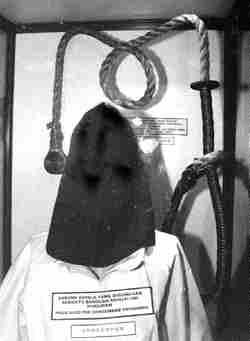|
Mona Fandey - A modern witchcraft
murder. |
Perhaps one of the most sensational and unusual cases of modern times in the Far East reached its conclusion on November 2nd, 2001 when Maznah Ismail, her husband Mohd Affandi Abdul Rahman and their 31 year old helper, Juraimi Hussin, were hanged at Malaysia's Kajang Prison on the outskirts of Kuala Lumpur.
Maznah was better known as Mona Fandey, which was her stage name, when she performed as a pop singer and water ballet dancer in her younger days. At her death, she was 45 years old, while her husband was a year younger. When her earlier career ran out of steam, she and Affandi made a living as witch doctors and were known locally as "bomohs." Belief in the powers of witchcraft is not uncommon among superstitious Malays, and they were able to attract a high class clientele which included politicians.
 In the photo a smiling Mona is being led away from
the court during her trial.
In the photo a smiling Mona is being led away from
the court during her trial.
The crime.
In July 1993, an assemblyman for central
Pahang state, Datuk Mazlan Idris, had approached Mona for supernatural help to boost
his political career and climb the party ladder. He was persuaded by the couple
to take part in a ritual in which he was to lay on the floor with his eyes
closed waiting for the money to "fall from the sky." No money fell,
instead it was the blade of an axe. Idris was
decapitated and then dismembered and partially skinned. His body was found cut
up into 18 parts and buried in a hole near Mona's home in the state of Pahang,
about 130 kilometres northeast of
Mazlan was reported missing on
Trial.
 Mona, Affandi and Juraimi were tried before Judge Datuk
Mokhtar Sidin sitting in
the Temerloh High Court in 1995, charged with murder
under Section 302 of the Malaysian penal code, a crime which carries a
mandatory death sentence.
Mona, Affandi and Juraimi were tried before Judge Datuk
Mokhtar Sidin sitting in
the Temerloh High Court in 1995, charged with murder
under Section 302 of the Malaysian penal code, a crime which carries a
mandatory death sentence.
The trial was a media sensation. Mona and Affandi
were an attractive couple in their late 30's accused of a gruesome, voodoo
related murder. Mona had a penchant for wearing expensive outfits to court each
day. Unlike most people on trial for her life, she always had a smile for the
media and seemed to revel in the attention. The picture right shows Mona and Affandi being taken to court.
The case lasted 65 days and heard evidence
from 76 witnesses. The prosecution told the court that money was the motive for
the killing and pointed to the shopping spree, the facelift and the Mercedes. Juraimi,
testified against Mona and Affandi and revealed the
gruesome details of the murder. It was alleged by the prosecution that Mazlan had been killed between
Affandi, in his defence, said Mazlan
owed him two million ringgit ($526,000) for a "magic cane," talisman and a
traditional hat said to have belonged to former Indonesian president Sukarno.
Mona testified that she also gave talismans and charms to several other UMNO
politicians to boost their popularity with the electorate.
It only took the seven member jury just 70 minutes to reach a unanimous verdict
of guilty against all three defendants. Affandi and
Mona smiled when the foreman of the jury delivered the verdict on
The judge then asked them if they had anything to say before he passed sentence
and Affandi and Mona replied that they would leave it
to the discretion of the court. He then passed the death sentence on each of
them - that they be taken from court to a recognised prison and later be hanged
till they were dead. After hearing her sentence Mona said, "I am happy and
thank you to all Malaysians." She was photographed smiling as usual as she
was led from the court to prison.
Their appeals were heard by the Chief
Justice of the Federal Court, Tun Mohd
Eusoff Chin, the Chief Judge
of Malaya, Datuk Wan Adnan
Wan Ismail and Federal Court Judge Datuk Dr Zakaria Yatim in the Federal
Court, Malaysia's highest court sitting in
Execution.
 The hangings were set for dawn on Friday, the 2nd of
November 2001 in the newly opened Kajang Prison. On
the previous day, Mona and Affandi were allowed an
eight hour visit with about a dozen members of their families. It was reported
that they spent their last hours advising their children from both their own
marriage and their previous marriages to "grow up to be good people"
and also told their children "jaga diri baik-baik" (to take
care of themselves well). A senior Prisons officer had said there was a lot of
crying and hugging as they spoke to their children and family for the last
time. It was also reported that Mona had said she would never die just before
she was executed. It is not known what she meant by that.
The hangings were set for dawn on Friday, the 2nd of
November 2001 in the newly opened Kajang Prison. On
the previous day, Mona and Affandi were allowed an
eight hour visit with about a dozen members of their families. It was reported
that they spent their last hours advising their children from both their own
marriage and their previous marriages to "grow up to be good people"
and also told their children "jaga diri baik-baik" (to take
care of themselves well). A senior Prisons officer had said there was a lot of
crying and hugging as they spoke to their children and family for the last
time. It was also reported that Mona had said she would never die just before
she was executed. It is not known what she meant by that.
It is normal practice in
The picture right, shows a Malaysian hood and noose which was on exhibition in Pudu Prison after it closed.
Before dawn on the Friday morning, the trio were each handcuffed and hooded in
their holding cells adjacent to the execution chamber and then led to the
gallows with its three British style nooses dangling from the metal beam. On
the trap, their legs were strapped and the nooses adjusted round their necks.
At
The bodies were left hanging for an hour before being taken down for autopsy
and then burial. Mona and Affandi were buried in a
cemetery in Kajang later in the morning, while Juraimi was buried in his hometown of Port Klang, in the Telok Gong Muslim
cemetery that afternoon.
After the executions, Mazlan's widow, Datin Faridah Zainuddin, told reporters that she could finally bury the past behind her and said she hoped now to carry on living her life with her children without the painful memories.
Comment.
It seems extraordinary in modern
times that a well educated man such as Mazlan Idris was, would believe in the power of witch doctors to bring
him wealth and further his career. Yet belief in superstition and the
supernatural is still strong in the
The crime itself seemed to have been committed entirely for greed and due to
Mona's impatience to spend their ill-gotten gains, was easily detected.
It is unclear what Mona meant when, on the eve of her execution, she said she
would never die. Whether she expected a last minute reprieve from the President
or whether she meant that her spirit would live on after the execution.
There was a hiatus in the death penalty in